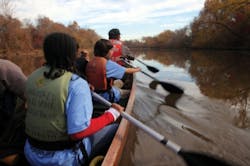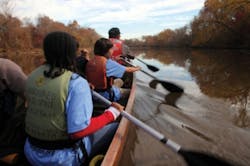New Smithsonian exhibit spotlights history, restoration of waterways worldwide
WASHINGTON, D.C., Nov. 29, 2012 -- Whether in literature, art, song or speech, mankind has always made reverential reference to rivers and waterways, recognizing the essential value of water to life itself. Despite this basic understanding, the waterways of the Earth have often been abused and some of greatest offenses have occurred in cities.
The Smithsonian's Anacostia Community Museum presents its groundbreaking exhibition "Reclaiming the Edge: Urban Waterways and Civic Engagement" on view through Sept. 15, 2013, which examines the consequences of the abuse of waterways worldwide and the efforts by communities to restore them. The exhibition explores in depth the history of use, decline and the movement to restore the Anacostia River in southeast Washington, D.C., and references similar stories of five urban waterways: the Los Angeles River; Suzhou Creek in Shanghai, China; the Thames in London; the Ohio in Louisville, Ky.; and the Allegheny/Monongahela rivers in Pittsburgh.
Developed by consulting scholar John R. Wennersten, professor emeritus at the University of Maryland, Eastern Shore and museum historian Gail S. Lowe, "Reclaiming the Edge" is the exhibition portion of an ongoing research project on urban waterways initiated by the museum in 2010 and adopted by the Smithsonian as one of its Grand Challenges. The exhibition commemorates the museum's 45th anniversary and is the first developed under the context of the organization's expanded mission to focus on issues affecting contemporary urban communities.
The challenges and visions posed by the impact of human settlement and industry on the Anacostia, such as the Navy Yard and the sports-stadium development, sewage/waste management, environmental justice issues and restoration of the environment, form the lens through which the approaches taken by other urban river communities are seen in the final section. Throughout the exhibition, viewers are challenged to consider their individual impact on the Anacostia river and specific ways citizens can do their part to clean the water.
"Experiences and points of view from men, women and children personally involved with their rivers distinguish this exhibition from others," said Lowe. "It is not just about science, biology, politics and industry, it is also about fishing, swimming, boating, drinking and enjoying the bounties clean waterways provide and our individual responsibility for keeping them healthy and safe."
"Reclaiming the Edge" features 75 objects, 16 works of art and 170 images. Highlights include:
- Five paintings by premier Chinese artist Zhang Jian-Jun selected from his 36-panel work on rivers
- A wooden "Gatita" (female kitten) painting by Chicano artist/environmentalist Leo Limon reminiscent of the cat faces he spray paints on the storm-drain covers along the L.A. River
- A stylized photo essay of the Anacostia River by local artist Bruce McNeil
- "Talking Trash," a mobile of a school of "fish" crafted from recycled bottles by interns working with the Smithsonian's Office of Exhibits Central
- "River Stories," eight digital stories in which local residents discuss their call to activism around river conservation
- "River of Memories," a video of older residents recalling memories of youthful interaction with the Anacostia River
The exhibition is funded in part by the Smithsonian Institution Women's Committee, the D.C. Commission on the Arts & Humanities, the headquarters and Region 3 offices of the U.S. Environmental Protection Agency and the Cornell Douglas Foundation.
About the Smithsonian's Anacostia Community Museum
Established in 1967, the Smithsonian's Anacostia Community Museum focuses on examining the impact of contemporary social issues on urban communities. For more information, call (202) 633-4820; for tours, call (202) 633-4844. Website: anacostia.si.edu.
###

